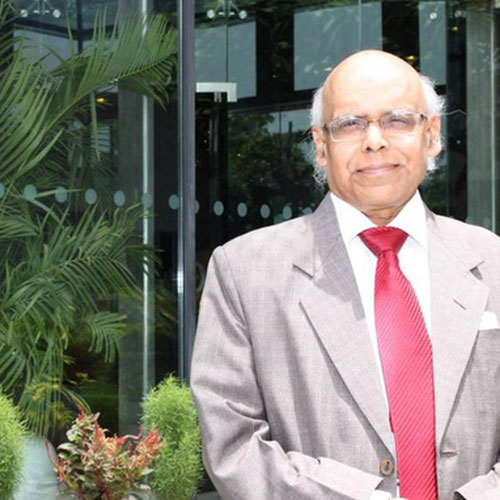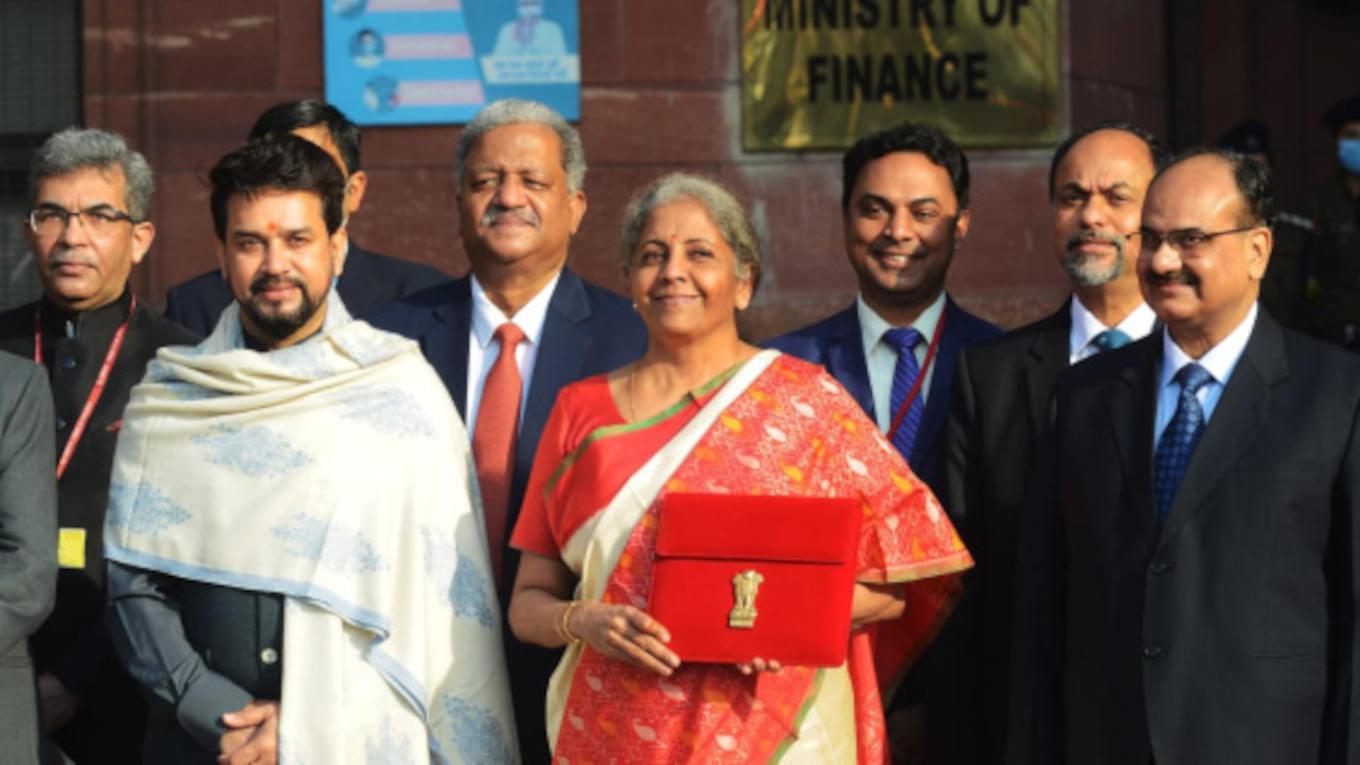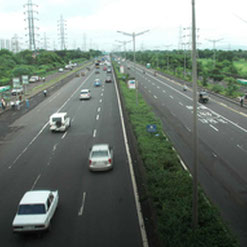-

Somanathan: we chose capex
The increased capital spending will come via the national infrastructure pipeline (NIP), as well as creation of mega textile parks and a push for roads and railways. Overall spending on infrastructure is up sharply by 35 per cent. It helps politically that the new road projects and infrastructure corridors are meant for the four states – West Bengal, Tamil Nadu, Assam and Kerala – which are going to the polls this year. A Development Financial Institution is on the cards that will finance the burgeoning needs of the infrastructure sector, with a starting capital Rs20,000 crore. This will hopefully kick-start spending and offer some relief to banks, which are reeling under a mountain of debt. Also in the works is an asset reconstruction & management company or a ‘bad bank’ that will take on unpaid debt
from existing banks to free up their lending capacity.
The commitment to privatisation has been renewed with a fresh target of Rs1.75 lakh crore. Two public sector banks, possibly Punjab National Bank and Bank of Baroda, have been added to the list. A Special Purpose Vehicle will be used to monetise government-owned land and other assets. The FDI limit in insurance sector has been raised to 74 per cent. Food subsidy for 2021-22 has been pared down to Rs2.4 lakh crore from Rs4.2 lakh crore for the current fiscal. All this has generated a feel-good factor.
Higher borrowing fallout
But then, you can’t have your cake and eat it too. The budget made the $950 billion bond market morose. The government’s borrowing in the current financial year (Rs12,80,000 crore) will remain elevated at Rs12,05,000 lakh crore in the next year. This has led to sharp slides in prices and rise in yields in the government securities (G-sec) market. Indeed, when the government demands so much money, the interest rate will move up. This will seriously crimp lending.
Sitharaman’s estimate of the current fiscal year’s budget deficit at 9.5 per cent is about 2 percentage points more than the consensus estimate. In the coming year, she wants to trim the shortfall, but not too drastically. The targeted deficit of 6.8 per cent of GDP will require the government to borrow aggressively once again, both from the bond market and from citizens’ small savings pool.
All eyes were on the Reserve Bank of India, which is the debt manager of the government. Given that the central bank also intends to buy the dollars flooding into India’s stock market to keep the rupee from rising too much, there’s a limit on how many government bonds it may purchase from banks. Some analysts believe that the RBI would be fine with the rise in yields to a certain extent but may resort to covert indications through auction cut-offs to bring down yields should they become uncomfortable. Side by side, RBI has chosen to open investment in G-secs to retail investors.
-
The commitment to privatisation has been renewed with a fresh target of Rs1.75 lakh crore. Two public sector banks, possibly Punjab National Bank and Bank of Baroda, have been added to the list
The enhanced capex and the gamble with the fisc is a tactical trade-off that any FM, particularly one saddled with the onerous task of steering the economy in these Covid times, has the liberty of making in constructing the budget. But here’s the catch: a comparison of the allocations in the 2021-22 budget for the Ministry of Railways, which will be a key driver of growth, with the revised estimates for 2020-21 fiscal actually showing a decline in allocation from Rs1,11,234 crore to Rs1,10,055 crore. The amount of money the Railways will have to generate from extra-budgetary resources has jumped by more than a fourth (up 28 per cent), indicating the need for higher borrowings. How this will impact the overall math of the budget remains to be seen.
Where are the jobs?
If there is one thing that strikes a jarring note, it is that the budget does little to address the immediate problem of job losses due to the lockdown. One just needs to go behind the smiles and hosannas to catch the familiar tale of distress. Sure, schemes and allocations have been announced across textiles, shipping and infrastructure sectors, which hold the promise of increased employment.
The push for big, long-gestation projects is good but may not result in many jobs – and, that too, immediately – which is the need of the hour. In any case, most construction jobs are created in residential and commercial projects, not in large infrastructure projects. Besides, most of these projects are going to be capital-intensive and one is not sure whether the private sector, despite the new initiatives like DFI, has yet developed the appetite for them.
Employment generation, however, is a recurring theme in the budget. The government feels that increased capital spending via the NIP, as well as creation of textile parks, disinvestment of PSUs and enhancement of the emergency credit line to MSMEs, will lead to more jobs. Post-disinvestment, the economic growth of PSUs and financial institutions will be through infusion of private capital, technology and best management practices. Besides, an estimated 140,000 jobs are being created in Central government departments between 2019 and March 2021. The strength of government establishments was 3,271,113 as on 1 March 2019, which is estimated to increase to 3,414,226 by 1 March 2021 – an increase of 143,113, according to the budget.
-

Goyal: no mention of the services sector
Yet, with five million young Indians entering the workforce annually, is that enough? And, mind you, this figure is three years old. According to McKinsey Global Institute, India needs to increase its rate of employment growth and create 90 million non-farm jobs between 2023 and 2030 for productivity and economic growth. Net employment rate needs to grow by 1.5 per cent per year from 2023 to 2030 to achieve 8-8.5 per cent GDP growth.
Little for MGNREGS, MSMEs
The budget has reduced the allocation for the Mahatma Gandhi National Rural Employment Guarantee Scheme (MGNREGS), the flagship programme for employment generation in villages, which turned out to be a lifeline for millions of unemployed migrant workers who had to return home during the lockdown. It has also not introduced any urban jobs initiatives along the lines of MGNREGS mooted by livelihood agencies in the wake of the pandemic-led distress. Somanathan, however, says MGNREGS is a demand-based scheme and if required, the government will provide more for it.
Experts also point to the lack of substantive relief for India’s micro, small and medium enterprises (MSME), a sector that employs nearly 40 per cent of the country’s informal workers. This sector was hit the worst by the lockdown with many small units going bankrupt. While the allocation for the MSME ministry in 2021-22 has doubled from the current financial year’s budget estimate of Rs7,572 crore to Rs15,700 crore, some 64 per cent of the allocation is for the Guarantee Emergency Credit Line facility, a scheme for providing fully guaranteed and collateral-free credit to MSMEs, business enterprises, individual entrepreneurs and Micro Units Development and Refinance Agencies (MUDRA) borrowers. The support to MSMEs is more in terms of liquidity and credit guarantees.
But, as Radhicka Kapoor, an economist and senior fellow at ICRIER, points out, as most of the sector is informal and unregistered, there will be limited uptake of the loans and credit guarantees. Besides, the conditions attached are as usually difficult to comply, leading to much lower offtake.
Services left in the lurch?
Our services sector, which accounts for 54 per cent of gross value-added (GVA), has been hit hard by the pandemic, particularly contact-based industries, such as hospitality and tourism, which will take longer to revive. The budget should have made provisions to boost this sector. “This was a great opportunity for the government to revive the tourism industry and save about 30 million jobs. Not just tourism, the budget has no mention of the services sector, which is our largest employment generator,” says Subhash Goyal, chairman, STIC Travel Group.
-
The push for big, long-gestation projects is good but may not result in many jobs – and, that too, immediately – which is the need of the hour
The budget does make a reference to the gig economy, where workers with temporary, flexible jobs instead of full-time employment are making up more and more of the 4 million-odd joining the workforce every year. Delivery boys, cleaners, packers, consultants along with professionals engaged in projects in sectors like IT, HR, and designing are part of the freelance labour platform, which has helped create global companies like Amazon and Uber, and their domestic cousins like Flipkart and Ola.
The nation owes more than a token of gratitude to gig workers who kept the wheels of online commerce running during the lockdown and came to our rescue as we worked from home. The Economic Survey admits that India will emerge as one of the largest countries for flexi staffing in the world. The budget merely talks of providing social security to gig and platform workers for the ‘first time globally’. But this is only a reiteration of the government’s code on social security. No allocation has been announced for the purpose. “The code mentions security for unorganised sector workers but it is largely advisory in nature. No budgetary allocation has been made for this unorganised sector apart from setting up a national database,” says Kapoor of ICRIER.
The code provides for a social security fund comprising contributions from gig employers and the Centre or state government, with gig companies expected to allot 1-2 per cent of their annual turnover. However, the code does not clearly define who a platform, gig and casual worker is, making this provision difficult to implement.
Textile parks without FTAs
Some budget ideas will need to be taken to logical conclusion, if they are to deliver results. For instance, mega investment textile parks have been conceptualised to enable the industry to become globally competitive, attract large investments and boost employment generation. The textile and apparel industry is among the top employers in the country, providing direct employment to 45 million people and 60 million people in allied industries.
Hetal Gandhi, director, textiles, CRISIL Research, points out that what will be critical here is our ability to negotiate free trade agreements (FTAs). “If you look at countries such as Vietnam and Bangladesh, the latter has an FTA with the EU, which gives it an upper hand when it comes to export of readymade garments compared to India,” she argues.
FTAs with the EU and the US will be crucial here as the two account for 64 per cent of India’s readymade garment exports. India’s share in such exports to the US and the EU remains stuck at 4-6 per cent, while that of competitors improved over the last five years.
India has kept out of the 15-nation Regional Comprehensive Economic Partnership (RCEP) but there is no reason it should not enter into FTAs with members of this grouping to get duty free access for value-added products like ready-made garments and made-ups.
Great expectations
Expectations from Budget 2021 were always high. For an economy battered by two years of slowdown, with a pre-pandemic annual growth rate of 4 per cent being a decadal low and the subsequent collapse in economic activity due to the pandemic, which is expected to contract the GDP by 7.7 per cent, this budget was expected to go beyond the nitty-gritty of numbers.
Except for one major act of transparency, the government continues to resort to budgetary subterfuge. The transparency relates to cleaning up of the balance-sheet of the Food Corporation of India (FCI), invested with the twin responsibilities of providing nutrition support through the Public Distribution System and the procurement operations at Minimum Support Prices. FCI was saddled with a debt of Rs3.75 lakh crore by the end of December 2020, a significant part of which is now paid by the government. So is the case of the fertiliser subsidy for which the pending Rs65,000 crore was cleared.
The government should have used the opportunity to come clean on its practice of using its off-budget borrowings on a massive scale through public sector agencies to avoid showing such borrowing in its own books. According to an SBI Research report, if the off-budget borrowings of Rs1.3 lakh crore and Rs30,000 crore during 2020-21 and 2021-22 respectively are taken into account, the deficit numbers would rise by 70 basis points to 10.2 per cent for 2020-21 and 6.9 per cent of GDP for 2021-22.
One interesting idea which has gone into the budget is the vehicle scrapping policy. The idea had been doing the rounds of the road transport ministry for several years. But its popularity became evident, when it was included in the budget. Auto stocks surged after the announcement.
-

Bhatia: encouraging budget
The policy is aimed at phasing out old and unfit vehicles. Vehicles will now undergo a fitness test in automated fitness centres after 20 years, in case of personal vehicles, and after 15 years, in case of commercial vehicles. Currently, there are an estimated 5.1 million light motor vehicles (LMV) above 20 years of age, 3.4 million LMVs above 15 years and 1.7 million medium and heavy motor vehicles above 15 years.
The policy will help in encouraging fuel-efficient, environment-friendly vehicles thereby reducing vehicular pollution and oil import bills. The metal from scrapped old vehicles will be reused by auto-makers and will bring down the manufacturing cost of new vehicles. This reduction in prices is likely to be transferred to consumers in the form of reduced prices for new vehicles. Its force-multiplier effect will be visible in increased sale of new vehicles which in turn will help the auto industry and its ancillary units, a big employer of skilled and semi-skilled labour. The automobile sector of India is one of the largest in the world and accounts for over 7.1 per cent of GDP and contributes to nearly 22 per cent of the country’s manufacturing GDP. Road transport minister Nitin Gadkari believes that the policy will lead to new investments of about Rs10,000 crore and create as many as 50,000 jobs.
Sleight of hand
Apart from smoke and mirrors, professional magicians also use sleight of hand and fancy footwork. In accounting terms, some of it is evident in this year’s budget documents. In 2016, Arun Jaitley’s budget was lauded, because of the greatly hyped increase in budgetary allocation to agriculture. The reality was that this was the outcome of simple shifting of one item (the interest subsidy paid to banks for credit to agriculture) from the Ministry of Finance head to the Ministry of Agriculture. This resulted in an increase in that ministry’s spending of Rs15,000 crore, thereby creating the illusion of much greater public expenditure on agriculture even with no change at all on the ground.
In 2021, Sitharaman’s budget flaunts the impressive figure of Rs2,23,846 crore on health, a 137 per cent increase over 2020-21. Health is a sector, which was always going to be the centre of attention in view of the raging pandemic. The National Health Policy had suggested 2.5 per cent of GDP should be earmarked as the health budget. The Finance Commission estimated that health budget for 2021-22 should be 0.68 per cent of GDP. A new Centrally-sponsored scheme – the PM Atmanirbhar Swasth Bharat Yojana – with plans to develop capacities of primary, secondary and tertiary health care, with an allocation of Rs65,000 crore over the next six years would be the fulcrum of a new programme.
-
Experts also point to the lack of substantive relief for India’s micro, small and medium enterprises, a sector that employs nearly 40 per cent of the country’s informal workers
However, the impressive allocation of Rs2,23,846 crore includes the expenditure on nutrition, water and sanitation. It also includes the Rs35,000 crore announced for the Covid-19 vaccines, a one-time expense, which even technically should not have been included as part of the regular health budget. Further, the Finance Commission grants for water and sanitation and health have also been lumped with it. Incidentally, the FC grants made by the Ministry of Finance, under the constitutional provision Article 275(1), are reflected in the health expenditure made by the states.
In her speech, Sitharaman justified all these inclusions because of a ‘holistic approach to health’
that focusses on ‘strengthening three areas – prevention, cure and well-being’. In reality, the Union health budget still remains at about 0.34 per cent of the GDP – a slight increase from 0.31 per cent last year. If a globally debilitating pandemic could not prompt the government to prioritise health spending, it is difficult to imagine what will!
Trick or treat
For most FMs, the bag of conjuror’s tricks never goes empty. Just when consumers were looking for some relief from record fuel prices, a move that could have acted as a force multiplier, the budget slapped agriculture infrastructure development tax of Rs2.50 and Rs4 a litre on petrol and diesel, respectively. Mercifully, pump prices will not rise as the impact of the agri cess has been offset by reducing in equal amounts the basic excise and special additional excise duties on the fuels.
The end result is that the amount of central taxes remains unchanged at Rs32.90 on a litre of petrol and Rs31.80 on diesel. This is akin to an act of picking from one pocket and putting it in another. A sum of Rs50,000 crore will thus be raised annually from the oil sector towards creating agriculture infrastructure, such as warehousing and storage. This, it is said, will boost the rural economy and enhance well-being of the farmer, who is reportedly unhappy with the new farm laws.
Well, the thing is that money raised from cess goes to the Centre directly. (The custom and excise duties go to the Consolidated Fund of India and the proceeds of the fund are often shared with the states.) So, in a bid to rope in more money, the government has raised the cess to balance the budget, at the expense of the states. Consumers will continue to be at the mercy of global crude prices. Granted, the centre can only use this money towards agri-Infra initiatives but the sneaky manner in which it has been achieved definitely raises some eyebrows.
-

Srivastava: the economy is normalising
Sitharaman has exuded confidence in the rest of her budget math as well. Her estimates for 2021-22 rest on buoyant revenue collection, aided by a 14.4 per cent surge in nominal growth. The bounce-back will help her in maintaining fiscal prudence and stick to the new consolidation road map outlined in the budget – from the current level of 9.5 per cent to 6.8 per cent in the coming fiscal year, gliding to an acceptable level of 4.5 per cent by 2025-26.
While her decision to come clean on the fisc is welcome, it is on expected lines. Earlier, the government was worried about expanding borrowing to support growth, fearing that could have led to a ratings downgrade. However, given the Covid environment, chances of a ratings downgrade are low as governments all over the world are taking recourse to fiscal leeway to fight the economic impact of the corona-virus. Fitch Ratings has been muted in its first reaction, merely saying that the fiscal deficit target in the near-term is higher than expected and medium-term consolidation is at a more gradual pace than anticipated. Nomura, however, expects the rating agencies to up the ante on this score sooner than later.
Ahead of the budget, there was speculation about an increase in the amount allocated to agriculture in view of the farmers’ agitation. Central ministers have also been bragging about an increase in the ministry’s allocation during the NDA tenure. The irony is that this amount has now been reduced. The government attributes this to the fact that the Agriculture Ministry did not spend its full budget during 2020-21, leading to a reduction in the allocation in the revised estimates (RE) for the current financial year and a lower outlay for the next one.
In Budget 2021-22, the two departments – Department of Agriculture, Co-operation & Farmers’ Welfare, as also Department of Agricultural Research and Education – under the Agriculture Ministry have been allocated a total amount of Rs1,31,531.19 crore, which is lower than the current financial year’s budget estimates (BE) of Rs1,42,762.35 crore, but just a tad higher than RE of Rs1,24,520.3 crore.
The surprising cut in the ministry’s budget is due to lower spending under the Pradhan Mantri Kisan Samman Nidhi (PM-Kisan) than the allocated sum. The government had allocated Rs75,000 crore for PM-Kisan in Budget 2020-21. This, however, was reduced to Rs65,000 crore in RE for 2020-21, but now, it has been retained at the same level for the next financial year. Under PM-Kisan, a marquee scheme by which Central ministers swear, Rs6,000 per year is provided to the eligible farmer families in three equal quarterly installments.
-
India has kept out of the 15-nation Regional Comprehensive Economic Partnership but there is no reason it should not enter into FTAs with members of this grouping to get duty free access
The total expenditure of Rs34,83,236 crore is just a marginal increase from the Rs34,50,305 crore (revised estimates for 2020-21). But the government feels that the boost in capital expenditure is noteworthy, as it tends to have a multiplier effect on the economy. The qualitative nature of expenditure, say finance ministry’s bureaucrats, will help lay the foundation of strong recovery in the next fiscal year.
Key is revenue buoyancy
The key to make all this happen is revenue buoyancy. The budgeted receipts (without borrowings) are Rs19,76,424, which is 23 per cent higher than the revised estimates of 2020-21. Gross tax receipts are pegged at Rs22,17,029 crore – a jump of 16.7 per cent. Non-tax revenue is expected to be Rs2,43,028 crore. “Our revenue figure is under-stated, not overstated,” says Tarun Bajaj, secretary, economic affairs. “We have taken nominal GDP at 14.4 per cent and revenue growth at 16.7 per cent. So, the buoyancy is only 1.16. We are hopeful we will get more than this”.
The government believes that, with a sharp bounce-back, the projected figures are achievable. Except for excise, all other heads are expected to register an increase. (A reduction in road and infra cess could bring excise collection down by 7 per cent.) The GST collection figures have shown a record increase in the months of December and January. Hopefully, the trend will sustain. The revenue stream will further be shored up by the robust divestment programme, with sales of marquee assets like Air India, BPCL and Concor expected to take off in the coming fiscal. The revenue from divestment is kept at Rs1.75 lakh crore. Earlier reports had suggested that the finance ministry was toying with the idea of fixing the disinvestment target at Rs2.5-3 lakh crore. But the government has chosen to be more realistic.
Hope and fears
“The government has indicated that it is willing to borrow significantly more than what FRBM targets currently allow, primarily for capital expenditures focussed on physical infrastructure,” explains D.K. Srivastava, chief policy advisor, EY India & member, Advisory Council to the 15th Finance Commission. “There are no additional taxes or funding mechanisms, so the government expects this will be financed through normal growth of GDP, through a virtuous cycle where the increased expenditure will reflect in growth. The only other revenues expected are from the monetisation of assets and disinvestment”.
-

Kapoor: no budgetary allocation for unorganised sector
“If the economy normalises, this path should be feasible,” he adds. “There are signs that the economy is normalising, but the question is whether India can bypass a second wave of Covid infections”.
The hardening prices of crude and other commodities is also a factor that the government will have to reckon with. Oil has already climbed to the highest level in over a year, as tightening global supplies and signs of strength in physical markets have aided crude’s virus-recovery rally. To the layman, this is reflected in the price of petrol and diesel. India’s crude oil imports in December soared to the highest levels in nearly three years to more than 5 million barrels per day (bpd), as its refiners cranked up output to meet a rebound in fuel demand.
Another risk that lurks is the possibility of a sub-normal monsoon in 2021. Only once in the past 20 years has India seen more than two consecutive years of normal monsoon. The past two years have seen good monsoons, and so, statistically speaking, the chances of 2021 witnessing an encore are low. Such an eventuality will have a bearing on GDP growth.
Sitharaman’s budget may have won her and the government some undiluted praise, at a time when the Modi dispensation is facing a serious political roadblock in the form of farmers’ protests. Now, she will have to ensure that her growth formula generates enough jobs to prevent popular unrest from boiling over. Indeed, the hard part begins now.








































